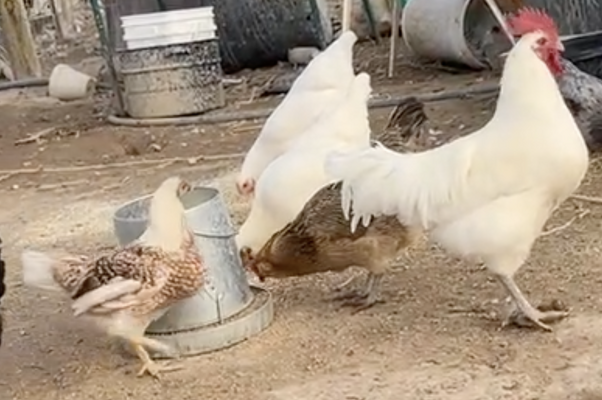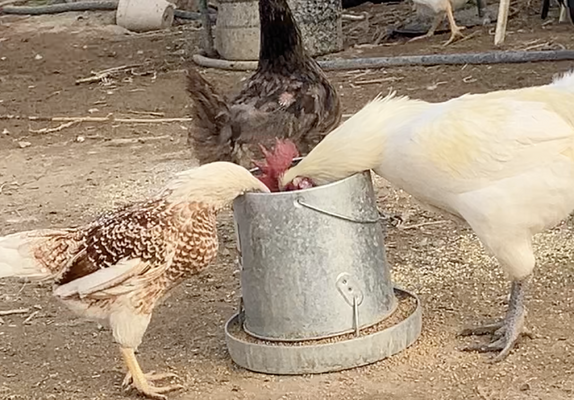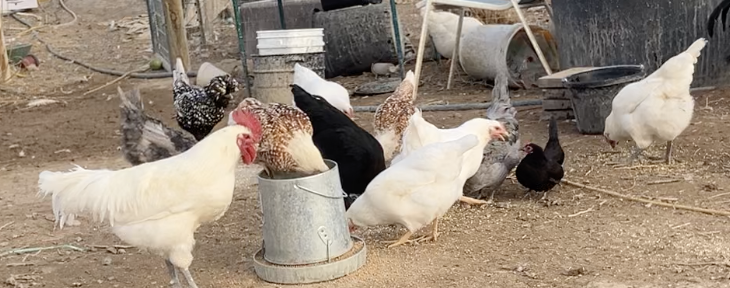Mine were the proper size and had no issues at all breeding
Navigation
Install the app
How to install the app on iOS
Follow along with the video below to see how to install our site as a web app on your home screen.
Note: This feature may not be available in some browsers.
More options
You are using an out of date browser. It may not display this or other websites correctly.
You should upgrade or use an alternative browser.
You should upgrade or use an alternative browser.
Heritage breed Cornish Chickens: why are they ignored and not widely bred
- Thread starter NewJourney
- Start date
-
- Tags
- cornish heritage breed rare
- Thread starter
- #62
NewJourney
Songster
As of right now my Cornish look less bulky than they should and aren’t growing quickly. Their legs are still very long and skinny. They haven’t bulked out yet. They have as much feed as they want or need, 24% “meatbird feed” and daily access to cracked corn and sunflower seeds. The one Cornish in the “hospital” has silky, tight feathers. Minimal down. Heavy for being so small. These are my first Cornish, I don’t have a reference point for quality or not on genetics. I assume bad quality because they are from a hatchery.
I’ve been thinking they still seem bantam sized especially seeing my Bresse rooster trying to mate with my little injured Cornish pullet. That’s the main reason I rescued her. Plus I saw a few of my female ducks seeming to gang up on her right after she tried to hobble away from my roo. She sat there trying to not be attacked for being lame. Poor thing.
She is only six months old. At six months should she be much closer to LF adult weight? I know they are slow growers. She appears to be similar size as the other four. I haven’t managed to catch the others and weigh them. These birds are the most flighty of my flock.
I’ve been thinking they still seem bantam sized especially seeing my Bresse rooster trying to mate with my little injured Cornish pullet. That’s the main reason I rescued her. Plus I saw a few of my female ducks seeming to gang up on her right after she tried to hobble away from my roo. She sat there trying to not be attacked for being lame. Poor thing.
She is only six months old. At six months should she be much closer to LF adult weight? I know they are slow growers. She appears to be similar size as the other four. I haven’t managed to catch the others and weigh them. These birds are the most flighty of my flock.
Those definitely sound like Cornish traits.The one Cornish in the “hospital” has silky, tight feathers. Minimal down. Heavy for being so small.
That makes me think they are undersized large fowl, not oversized bantams. It sounds like they probably have the potential to get a bit bigger (heavier) than they currently are.As of right now my Cornish look less bulky than they should and aren’t growing quickly. Their legs are still very long and skinny. They haven’t bulked out yet.
I would expect a bit more weight at this age, but I don't know for sure.She is only six months old. At six months should she be much closer to LF adult weight? I know they are slow growers.
I wonder if they aren't getting enough to eat?
That should provide what they need to grow well, if they are actually eating it. Is there any chance they are being chased away by the other birds?They have as much feed as they want or need, 24% “meatbird feed” and daily access to cracked corn and sunflower seeds.
These birds are the most flighty of my flock.
If the Cornish are avoiding the other birds and that makes them go hungry, that could explain the small weight.I saw a few of my female ducks seeming to gang up on her right after she tried to hobble away from my roo. She sat there trying to not be attacked for being lame. Poor thing.
Of course poor-quality hatchery stock is another explanation for the small weight.
I'm not good at knowing whether chickens are "good" or "bad" quality unless there is something obvious like the weight being off or a bird being completely the wrong color.These are my first Cornish, I don’t have a reference point for quality or not on genetics. I assume bad quality because they are from a hatchery.
Regarding quality of hatchery birds: the sizes are often wrong, generally tending toward middle sized birds. So bantams often run too big and giant breeds are often too small. Details of the appearance are often a bit wrong (color and pattern, comb type, leg color, shape of body, whether or not they have crests, muff/beard, feathered feet, etc.)
For dual purpose and meat breeds, hatchery birds may lay better than the breeder-quality, because a hatchery is mostly in the business of hatching eggs to produce chicks. Hatchery birds are generally healthy in the sense that they do not need special care or feed supplements.
Basically, it's what happens if you put a bunch of chickens in a pen, keep the feeder and waterer full, and hatch every egg they lay, then take all the chicks that hatched in a given week to be your breeders for the next generation. You get the most chicks from the hens that lay the most eggs, and you get no chicks from birds that die or fail to lay, so there is an automatic selection for increased egg laying and general good health.
- Thread starter
- #64
NewJourney
Songster
I wonder if they aren't getting enough to eat?
No, they are doing great. The only one that seems to be having issues was the one that was just injured. I have never seen any of them gang up on the Cornish. They are the lowest in the pecking order right now, though. But no, they get plenty of food access. They tend to be the last to eat, but I always ensure there's enough food to last through the night. I know my ducks prefer to eat at night.Is there any chance they are being chased away by the other birds?
This is probably the issue. One of the five has what I think is called rooster coloration. I call her Rosie. Most of her feathering is red without white lacing. She's the one that tends to hop up on taller objects the most. I really thought she was a cockerel except she isn't any bigger than the others and her face isn't red yet. She's never crowed.Of course poor-quality hatchery stock is another explanation for the small weight.
Regarding quality of hatchery birds: the sizes are often wrong, generally tending toward middle sized birds. So bantams often run too big and giant breeds are often too small. Details of the appearance are often a bit wrong (color and pattern, comb type, leg color, shape of body, whether or not they have crests, muff/beard, feathered feet, etc.)
This photo were taken a month ago.

These were taken from videos recorded Dec 11th.
White American Bresse pullet 5 weeks older, at 7 mos, Cornish at 6 mos.

Cornish (6 mo) , Easter Egger (9.5 mo), WABresse (6 mo), White Rock, WABresse cockerel (7 mo)

Badly molting Sapphire Gem (1.5 years old), and WABresse cockerel for size comparison.

Also a young OEGB, bantam Polish, 6 month old BCM and Prairie Blue Bell Egger.

Those comparison pictures gave me an idea: maybe weigh a few of the other-breed pullets to see how heavy they are. That might give some idea of normal growth rates for chickens of that age (I am realizing I don't know enough about that!)No, they are doing great. The only one that seems to be having issues was the one that was just injured. I have never seen any of them gang up on the Cornish. They are the lowest in the pecking order right now, though. But no, they get plenty of food access. They tend to be the last to eat, but I always ensure there's enough food to last through the night. I know my ducks prefer to eat at night.
This is probably the issue. One of the five has what I think is called rooster coloration. I call her Rosie. Most of her feathering is red without white lacing. She's the one that tends to hop up on taller objects the most. I really thought she was a cockerel except she isn't any bigger than the others and her face isn't red yet. She's never crowed.
This photo were taken a month ago.
View attachment 4019022
These were taken from videos recorded Dec 11th.
White American Bresse pullet 5 weeks older, at 7 mos, Cornish at 6 mos.
View attachment 4019026
Cornish (6 mo) , Easter Egger (9.5 mo), WABresse (6 mo), White Rock, WABresse cockerel (7 mo)
View attachment 4019027
Badly molting Sapphire Gem (1.5 years old), and WABresse cockerel for size comparison.
View attachment 4019028
Also a young OEGB, bantam Polish, 6 month old BCM and Prairie Blue Bell Egger.
View attachment 4019029
Rose the Legbar
Songster
Pretty sure your girls are just oversized bantams. I have some banty cornish that are HEAVY but tiny! Pullets as well. The breeder I got my two from says that most bantam cornish weigh in on the larger and heavier side.
Photo of my heavier cornish bantam next to a very angry large foul SLW. I haven’t weighed the cornish yet but she is around 3LBS if I were to guess.

Photo of my heavier cornish bantam next to a very angry large foul SLW. I haven’t weighed the cornish yet but she is around 3LBS if I were to guess.
- Thread starter
- #67
NewJourney
Songster
I think you're right. She seems to be a large bantam. I have the injured one inside with me. I finally noticed a difference in her legs. Her left leg, the one she's refusing to walk on is definitely injured. I finally see swelling and a bite mark from my dog. I also notice her left wing may also be bitten and possibly broken at the tip of the wing. Poor thing. I wrapped her leg up into her body to stabilize it and added padding underneath on her breastbone from an old bra that had padding that I never used (LOL) and tied it around her. I noticed all along her keel is missing feathers. Since she can't roost, she is lying on her breastbone a lot. I don't want her getting sore. Poor thing. I'll keep her inside for a week and I hope by then she'll at least be starting to put a little weight on it.Pretty sure your girls are just oversized bantams. I have some banty cornish that are HEAVY but tiny! Pullets as well. The breeder I got my two from says that most bantam cornish weigh in on the larger and heavier side.
Photo of my heavier cornish bantam next to a very angry large foul SLW. I haven’t weighed the cornish yet but she is around 3LBS if I were to guess.View attachment 4020050
I'm falling in love with her. She's starting to really open my eyes more to the possibility with the breed. I hope in the spring I can get some good quality full size LF chicks.
cornishcrossing
Hatching
- Mar 23, 2025
- 3
- 0
- 2
I may depend on where you buy them as to their hardiness. My flock came from A breeder in Kansas whose Grandfather brought them over from England 108 or so years ago. I've had my flock since 2014. They don't lay as many eggs as other breeds so it is a little more challenging.I was looking for Cornish Chickens earlier this year. I had a terrible time trying to find them through breeders all across the USA. There are none. At least, there are none that are publicly mentioned on any website that lists breeders of chicken breeds. The ones I found were no longer breeding/selling them. I only found two hatcheries that sell any variety of Cornish, and both of them had nearly non-existent availability for chicks. I only saw Dark and White Laced Red Cornish.
Why?
These strange birds are very rare here in the United States, but the Livestock Conservancy states it's only in "watch" status. That seems wrong.
It seems to be that nobody wants to breed these birds and keep their lines active. I see through research that they don't lay very many eggs, and the mating success is low. Are these the reasons for ridiculously low availability through hatcheries and non-existent breeders across the nation?
As soon as my birds reach maturity I will be breeding them.
These birds are a major component in the trademarked and hidden lines of the commercial broilers. I believe this is why many people are not breeding them. I think that the hobby farm and homesteaders don't want to be seen as "competing" with the major producers of Cornish Cross. Perhaps they have been sued. I don't know. It just seems so odd to me that the Cornish is barely being produced here in the US.
I have a few breeding pairs left in Ava, Mo. for sale for $100, while they last.
White Cornish Chickens for sale
New posts New threads Active threads
-
Latest threads
-
-
Bumble Foot? Help!
- Started by MJ_SilkieSaloon
- Replies: 0
-
-
Training my girls to go in their coop
- Started by jestes2252
- Replies: 1
-
-
-
Threads with more replies in the last 15 days
-
-
24 hour old chick with legs and feet issue.
- Started by Beckys Birds
- Replies: 111
-
-
Need advice for the best vines and plants for in a chicken run!
- Started by ChickenShepherd_6116
- Replies: 75
-
Possible poisoning? Please help
- Started by SemiSweet2391
- Replies: 71
-
×




